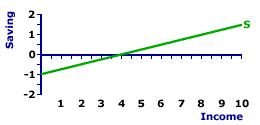
|
|
MARKET POWER: The ability of buyers or sellers to exert influence over the price or quantity of a good, service, or commodity exchanged in a market. Market power largely depends on the number of competitors on each side of the market. If a market has relatively few buyers, but many sellers, then limited competition on the demand-side of the market means buyers tend to have relatively more market power than sellers. The converse occurs if there are many buyers, but relatively few sellers. This is also termed market control.
Visit the GLOSS*arama
|
|


|

|
                           INTERCEPT, SAVING LINE: The intercept of the saving line indicates autonomous saving, saving that does not depend on the level of income or production. This can be thought of as the baseline level of saving that would be undertaken if income falls to zero. Autonomous saving is affected by the consumption expenditures determinants, which cause a change in the intercept and a shift of the saving line. The value of the intercept of the saving line is the negative of the value of the intercept of the consumption line. | Saving Line | 
|
The saving line, also termed propensity-to-save line or saving function, shows the relation between saving and income for the household sector. The income measure commonly used is national income or disposable income. Occasionally a measure of aggregate production, such as gross domestic product, is used instead.A representative saving line is presented in the exhibit to the right. This green line, labeled S in the exhibit, is positively sloped, indicating that greater levels of income generate greater saving by the household sector. This positive relation corresponds to the fundamental psychological law of Keynesian economics. The saving line graphically illustrates the saving-income relation for the household sector, which is the foundation of the leakages line used in Keynesian economics to identify equilibrium income and production. The intercept of the saving line indicates the intersection point between the saving line and the vertical saving axis. The saving line intersects the vertical axis at a value of -$1 trillion. Theoretically, this is a minimum "baseline" level of saving, the amount of saving undertaken if income falls to zero. This level happens to be negative because consumption exceeds income. More to the point, this intersection indicates autonomous saving--saving unrelated to income. Click the [Intercept] button to illustrate. Autonomous saving is saving by the household sector that is unrelated to and unaffected by the level of income or production. This is best indicated by a zero level of income. While individuals occasionally come face-to-face with autonomous saving, as their incomes drop to zero due to unemployment, for the aggregate economy autonomous saving is mostly an unlikely theoretical extrapolation. However, from an analytical perspective, the intercept of the saving line is affected by the consumption expenditures determinants. These are ceteris paribus factors other than income that affect consumption and thus also affect saving, but which are held constant when the saving line is constructed. Any change in these determinants cause the saving line to shift, which necessarily means a new intercept and a new level of autonomous saving.

Recommended Citation:INTERCEPT, SAVING LINE, AmosWEB Encyclonomic WEB*pedia, http://www.AmosWEB.com, AmosWEB LLC, 2000-2024. [Accessed: April 28, 2024].
Check Out These Related Terms... | | | | | | | | | | | | | | |
Or For A Little Background... | | | | | | | | | |
And For Further Study... | | | | | | | | | | | | | | | |
Search Again?
Back to the WEB*pedia
|



|

|
GREEN LOGIGUIN
[What's This?]
Today, you are likely to spend a great deal of time waiting for visits from door-to-door solicitors seeking to buy either a combination CD player, clock radio, and telephone (with answering machine) or a revolving spice rack. Be on the lookout for slow moving vehicles with darkened windows.
Your Complete Scope
This isn't me! What am I?
|

|
|
It's estimated that the U.S. economy has about $20 million of counterfeit currency in circulation, less than 0.001 perecent of the total legal currency.
|

|
|
"The roots of education are bitter, but the fruit is sweet." -- Aristotle
|

|
COD
Cash on Delivery
|

|
|
Tell us what you think about AmosWEB. Like what you see? Have suggestions for improvements? Let us know. Click the User Feedback link.
User Feedback
|


|


